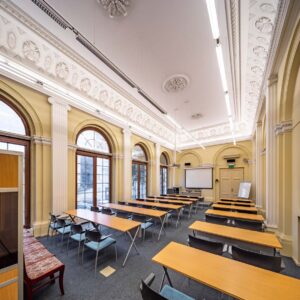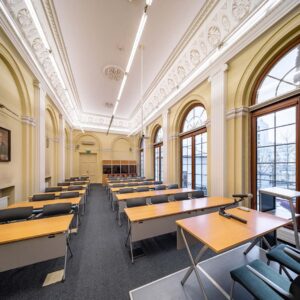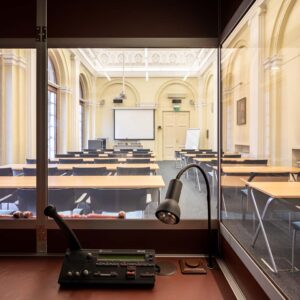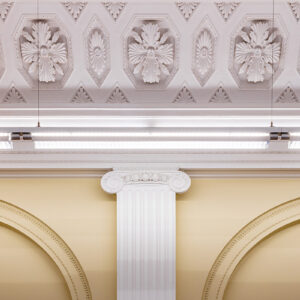- Wall-mounted screen
- Flipchart
- Laptop
- Microphones, 2 pcs
- Number of seats – theater setting: up to 80
- Number of seats – table sides setting: up to 80
- Possibility to organize a secretariat in the lobby: yes
Number of seats – oval table setting: none - Possibility to organize a secretariat in the lobby: yes
- Possibility to use a smaller room, directly connected to the main room: yes
- Possibility to use a terrace: yes
- Possibility to organize a buffet around the room: yes
- Possibility to arrange an exhibition space: yes
- Possibility to use recesses and additional rooms: yes
- Circular windows under the dome on the north side and balcony doors leading to the terrace
- View from the terrace to the inner courtyard
- Direct access to the elevator in the lobby
The Gen. Jan Henryk Dąbrowski Hall is the only conference room located in the first floor of the palace. There is a passage running to it from the main hall, which favors its use as a lecture hall for open public events held in the the Staszic Palace, as well as a place for temporary exhibitions and presentation of collections in showcases. The rectangular room has a classroom-type setting with 36 seats (6×4+6×2), and it is possible to adjust it to a theatre-type setting with 70 seats. This is a typical multimedia room with a booth for simultaneous interpretation. New solutions blend with historicism and stylization in the Corazzian fashion, alluding to the original likeness of the palace. The use of original, as for the the Staszic Palace building, new type of lighting (fluorescent lamps suspended on slats) matches the ceiling stuccowork. The view from the balcony windows offers a glimpse of the inner palace courtyard from the side of the neighboring building of the Warsaw Hospital for Children, existing in this location since 1875.
The contemporary stretch of the building, where the presented hall is found, includes a part that was not included in the original plan. With the plan of annexing wings towards Świętokrzyska Street, by Piotr Biegański (during the post-WWII reconstruction of the palace), the present room was constructed in this place. Similarly to the Maria Skłodowska-Curie Hall on the first floor, its concept was developed in the 1940s by combining historicism and Corazzian style with office space needs.
The naming of the hall after General Jan Henryk Dąbrowski refers to events organized here with the participation of the public as well as temporary exhibitions, during which collections are often displayed in showcases. This function of the presented room determines the connection of this fragment of the building with museum space established in the palace in 1823. Situated “at the crossroads” of the space neighboring the historical hall and the new fragment of the building, the hall, in a way, becomes a symbolic space of transition, linking the “old” with the “new”, the past with the present. It can be a symbol of the continuation of tradition, cultivated and processed under varying conditions. The room common name “multimedia room” draws attention to the presence of solutions that are obvious to the 21st-century palace users who live in the era of digital and wireless communication. However, it is a trace of progress, which in the space of the the Staszic Palace combines with history and tradition. Importantly, in the work run within the walls of the the Staszic Palace, old patterns and work merge with the potential of new solutions and current needs brought about by the development of scientific disciplines, and, more broadly, the advancement of civilization.
Aleksandra Wójtowicz



